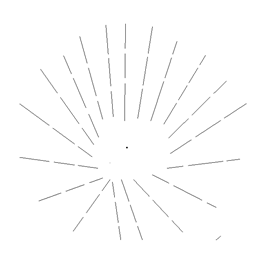This set of Engineering Materials & Metallurgy Multiple Choice Questions & Answers (MCQs) focuses on “Diffraction”.
1. In which case can the rotating crystal method for determining crystal structure be used?
a) Single crystal
b) Polycrystalline
c) Fine-grained polycrystalline
d) Cold worked crystals
View Answer
Explanation: X-ray diffraction is a technique used for determining and examining the condition of a crystal structure. Laue method is used for single crystals or polycrystalline masses, rotating crystal method is applicable for single crystals, whereas the powder method is applicable for finely divided crystalline powder.
2. What is the resultant image formed for very fine grains in the Laue back reflection method?
a) Few clear spots
b) Large number of spots
c) Continuous rings
d) Irregular spots
View Answer
Explanation: X-ray diffraction is a technique used for probing the state of a crystal structure. Laue back reflection method is used for single crystals or polycrystalline masses. In this method, for very fine grains of 0.0004 mm show a back reflection photograph of continuous rings which are doubly resolved.
3. When are irregular spots in the Laue method formed?
a) Coarse grains > 0.04 mm
b) Fine grains 0.004 mm
c) Very fine grains 0.0004 mm
d) Cold worked
View Answer
Explanation: Laue back reflection method is used for examining and measuring the condition of single crystals or polycrystalline masses. For cold worked metal, the back reflection photograph has an irregular shape and outline of the spots. Cold working, thus, causes the spots to widen radially.
4. Which state of metal does this figure depict?

a) Coarse grains > 0.04 mm
b) Fine grains 0.004 mm
c) Very fine grains 0.0004 mm
d) Distorted crystal
View Answer
Explanation: X-ray diffraction is a technique used for investigation of the state of a crystal structure. Laue back reflection method is used for single crystals or polycrystalline masses. The given figure depicts the distorted form of a crystal.
5. The intensity of the initial neutron in neutron diffraction is reduced by a factor of ________
a) 102
b) 103
c) 105
d) 107
View Answer
Explanation: For neutron diffraction, a nuclear reactor is used as the initial source of neutrons. However, the intensity of the initial neutron is reduced by a factor of about 103 in this operation. After further diffraction, the resulting beam is rather weak.
6. What is the relative neutron scattering power of iron?
a) 1.8
b) 5.4
c) 7.7
d) 11.4
View Answer
Explanation: Iron and cobalt generally have atoms of similar atomic numbers, which makes them difficult to study. Through neutron diffraction, the values can be clearly determined. Iron has a scattering power of 11.4, whereas it is only 1.0 for cobalt.
7. What is the relative X-ray scattering power of iron and cobalt?
a) 1 and 1
b) 4 and 6
c) 12 and 13
d) 26 and 27
View Answer
Explanation: Iron and cobalt generally have atoms of similar atomic numbers, which makes it difficult to study their structures. The relative X-ray scattering power of iron and cobalt is 26 and 27 respectively. However, these values can be clearly determined by neutron diffraction method.
8. Which bond has a fluctuating charge?
a) Dispersion
b) Dipole
c) Ionic
d) Covalent
View Answer
Explanation: A fluctuating net charge is formed in a dispersion bond since adjacent atoms in the molecule repel each other. The fluctuating charge on one molecule interacts with another, which results in a net attraction. Due to this, a dispersion bond is formed.
Sanfoundry Global Education & Learning Series – Engineering Materials & Metallurgy.
To practice all areas of Engineering Materials & Metallurgy, here is complete set of 1000+ Multiple Choice Questions and Answers.
If you find a mistake in question / option / answer, kindly take a screenshot and email to [email protected]
- Practice Metallurgical Engineering MCQs
- Apply for Metallurgical Engineering Internship
- Check Metallurgical Engineering Books
- Check Engineering Materials Books
